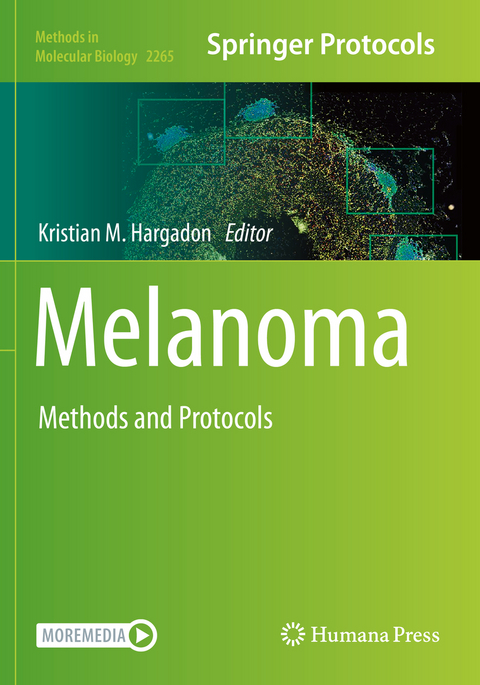
Melanoma
Springer-Verlag New York Inc.
978-1-0716-1207-1 (ISBN)
Authoritative and comprehensive, Melanoma: Methods and Protocols aims to serve basic research scientists and clinicians who bring questions from the clinic into the lab in order to translate observations in the laboratory into improved patient care for this highly malignant form of cancer.
Chapter 14 is available open access under a Creative Commons Attribution 4.0 International License via link.springer.com.
Model Systems for the Study of Malignant Melanoma.- Generation of Functional Gene Knockout Melanoma Cell Lines by CRISPR-Cas9 Gene Editing.- A Fluorescent Gelatin Degradation Assay to Study Melanoma Breakdown of Extracellular Matrix.- Wound Healing Assay for Melanoma Cell Migration.- A Fluorescence-Based Assay for Measuring Glucose Uptake in Living Melanoma Cells.- Analyzing Melanoma Cell Oxygen Consumption and Extracellular Acidification Rates Using Seahorse Technology.- Analysis of Melanoma Cell Glutamine Metabolism by Stable Isotope Tracing and Gas Chromatography-Mass Spectrometry.- Determination of Cytotoxic Activities Against Melanoma Cells Using Flow Cytometry.- In Vitro Differentiation of Tumor-Associated Macrophages from Monocyte Precursors with Modified Melanoma-Conditioned Medium.- A Flow Cytometric Assay for Investigating Melanoma Cell Adhesion to Lymphatic Endothelial Cells.- An Approach to Study Melanoma Invasion and Crosstalk with Lymphatic Endothelial Cell Spheroids in 3D Using Immunofluorescence.- Evaluating Melanoma Viability and Proliferation in 3D Microenvironments.- Preparation, Drug Treatment, and Immunohistological Analysis of Tri-Culture Spheroid 3D Melanoma-Like Models.- Enrichment of Melanoma Cancer Stem Cells via Sphere Assays.- Capture and Isolation of Circulating Melanoma Cells Using Photoacoustic Flowmetry.- Multi-Marker Immunomagnetic Enrichment of Circulating Melanoma Cells.- PD-L1 Detection on Circulating Melanoma Cells.- Transcript-Based Detection of Circulating Melanoma Cells.- Isolation and Quantification of Plasma Circulating Tumor DNA from Melanoma Patients.- Simultaneous BRAFV600E Protein and DNA Aberration Detection in Circulating Melanoma Cells Using an Integrated Multi-Molecular Sensor.- Single Cell Analysis of BRAFV600E and NRASQ61R Mutation Status in Melanoma Cell Lines as Method Generation for Circulating Melanoma Cells.- A Rapid Exosome Isolation Using Size Exclusion Chromatography(REIUS) Method for Exosome Isolation from Melanoma Cell Lines.- Immunoaffinity-Based Isolation of Melanoma Cell-Derived and T Cell-Derived Exosomes from Plasma of Melanoma Patients.- An Immunocapture-Based Assay for Detecting Multiple Antigens in Melanoma-Derived Extracellular Vesicles.- Post-Lymphadenectomy Analysis of Exosomes from Lymphatic Exudate/Exudative Seroma of Melanoma Patients.- Fate Mapping of Cancer Cells in Metastatic Lymph Nodes Using Photoconvertible Proteins.- Detection of Melanoma Cells in Lymphatic Drainage (LD) after Lymph Nodes Dissection via Nested RT-PCR Analysis of Molecular Melanocytic Markers.- A Clonogenic Assay to Quantify Melanoma Micrometastases in Pulmonary Tissue.- PET Imaging of Melanoma Using Melanin-Targeted Probe.- Imaging and Isolation of Extravasation-Participating Endothelial and Melanoma Cells During Angiopellosis.- Salivary Proteomic Analysis of Canine Oral Melanoma by MALDI-TOF Mass Spectrometry and LC-Mass Spectrometry/Mass Spectrometry.- Detection of Uveal Melanoma by Multiplex Immunoassays of Serum Biomarkers.- Unbiased Microbiome and Metabolomic Profiling of Fecal Samples from Patients with Melanoma.- Assessment of Cell-Free microRNA by NGS Whole Transcriptome Analysis in Cutaneous Melanoma Patients’ Blood.- High-Throughput Identification of miRNA-Target Interactions in Melanoma Using miR-CATCHv2.0.- Immunotyping and Quantification of Melanoma Tumor–Infiltrating Lymphocytes.- Single Cell Gene Expression, Clonality, and Feature Barcoding of Melanoma Tumor Infiltrating Lymphocytes.- Using Mass Cytometry to Analyze the Tumor-Infiltrating Lymphocytes in Human Melanoma.- Multiplex Immunohistochemistry Analysis of Melanoma Tumor Infiltrating Lymphocytes.- Multiplex Immunofluorescence Histology for Immune Cell Infiltrates in Melanoma-Associated Tertiary Lymphoid Structures.- The Use of Nanoparticles in the Delivery of Nucleic Acids for Melanoma Treatment.- siRNA Delivery to Melanoma Cells with Cationic Niosomes.- Controlled Delivery of Plasmid DNA to Melanoma Tumors by Gene Electrotransfer.- Generation of Murine Chimeric Antigen Receptor T Cells for Adoptive T Cell Therapy for Melanoma.- Generation of Phosphopeptide-Specific T Cell Lines as Tools for Melanoma Immunotherapy.
| Erscheinungsdatum | 18.03.2022 |
|---|---|
| Reihe/Serie | Methods in Molecular Biology ; 2265 |
| Zusatzinfo | 97 Illustrations, color; 25 Illustrations, black and white; XX, 674 p. 122 illus., 97 illus. in color. |
| Verlagsort | New York, NY |
| Sprache | englisch |
| Maße | 178 x 254 mm |
| Themenwelt | Medizin / Pharmazie ► Medizinische Fachgebiete ► Onkologie |
| Medizin / Pharmazie ► Studium | |
| Schlagworte | cell culture systems • circulating tumor DNA • Disease Biomarkers • Human melanoma cell lines • Immune cell infiltrates • skin cancer |
| ISBN-10 | 1-0716-1207-7 / 1071612077 |
| ISBN-13 | 978-1-0716-1207-1 / 9781071612071 |
| Zustand | Neuware |
| Haben Sie eine Frage zum Produkt? |
aus dem Bereich


